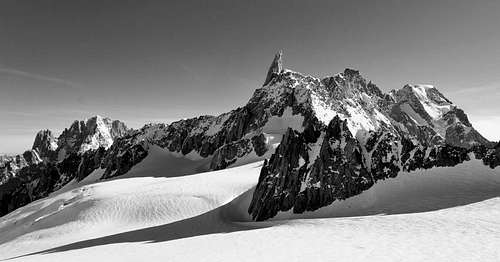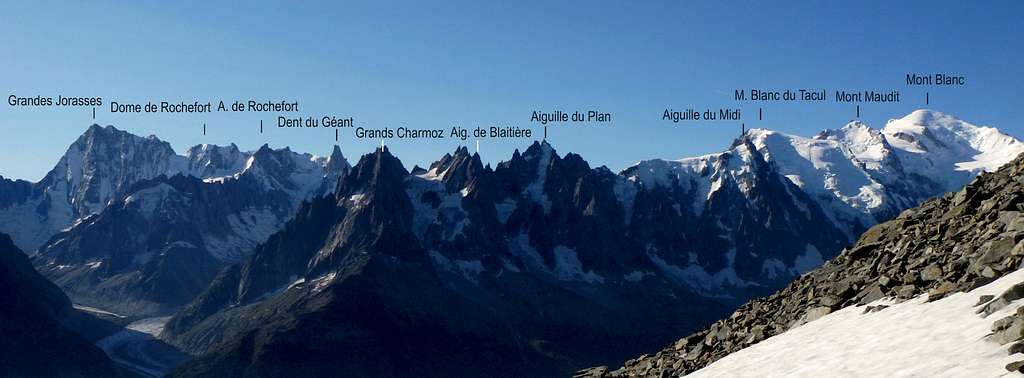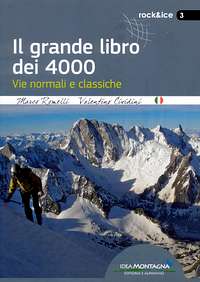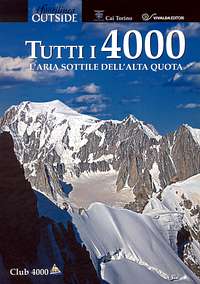-
 48905 Hits
48905 Hits
-
 86.85% Score
86.85% Score
-
 23 Votes
23 Votes
|
|
Route |
|---|---|
|
|
45.86287°N / 6.95109°E |
|
|
Mountaineering, Ice Climbing, Mixed |
|
|
Summer |
|
|
Most of a day |
|
|
AD, V+ without fixed ropes aid, III, IV with aid |
|
|
Overview
Geographical classification: Mont Blanc Group > Dent du Géant > Dent du Géant SW Face
Dent du Géant SW Face (Normal route)
Dent du Géant or Dente del Gigante in italian - meaning Giant's Tooth - is a 4000s located in the Northern part of the massif of Mont Blanc, near the border between Italy and France, but entirely in French territory. It is situated between Colle del Gigante 3.359 m and the Grandes Jorasses 4.206 m, on the ridge running from the summit of Mont Blanc to Mont Dolent. Dent du Géant rises like a huge canine from the "Gengiva" - meaning Gum - a socket of snow and rock culminating with a white snow cap overlooking the Glacier du Geant. The profile of this superb rocky spire is very famous and it is one of the Mont Blanc Group icons.
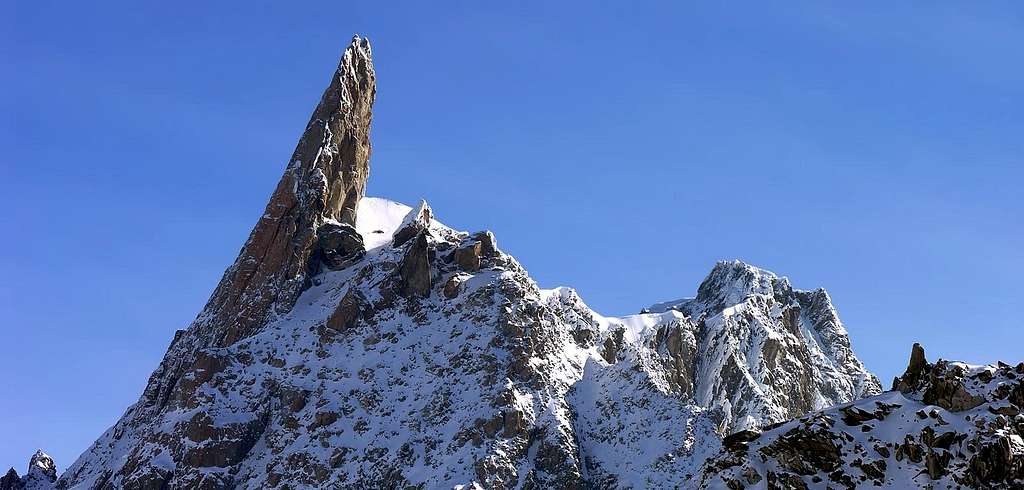
The summit consists of two clearly identified tops, about thirty meters away from each other: Punta Sella 4009 m to the South-West and Punta Graham 4.014 m, the highest, to the North-East. On Punta Graham has been erected a statue of Mary. The most attended route to reach the top of this magnificent spire is the Normal route on the SW side, the route of the first climbers, a classic of the Mont Blanc massif.

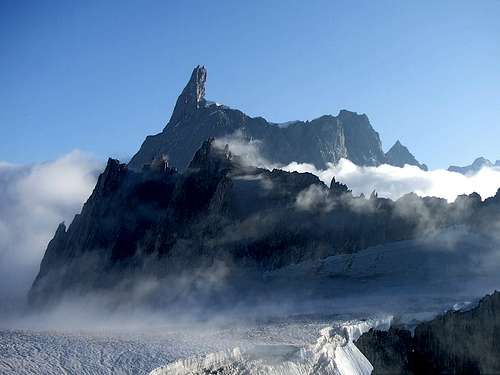
It's a beautiful ascent that opposes difficulties V+ UIAA in free climbing, without using the fixed ropes that have been positioned on this steep and impressive wall, while using the fixed ropes the degree befalls to III and IV UIAA. Just a magnificent ascent on excellent rock inside a great setting with breathtaking views over all the highest summits of the massif (Monte Bianco, Mont Maudit, Tacul), over Rochefort, Grand Jorasses, Mer de Glace. Consequently the route is frequently attended and on clear days.
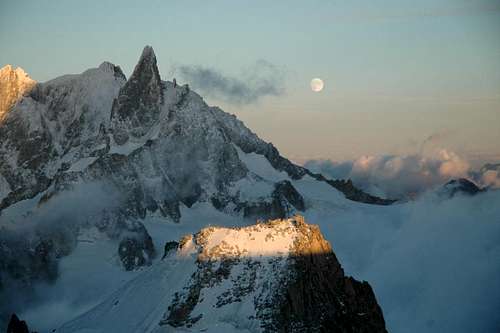
It may even be crowded, also because in theory it's possible to climb in a day, starting with the first races of the cable car rising up From Entreves to Torino hut...into practice this is quite an unwise solution, due to the lack of proper acclimatization. Despite the presence of fixed ropes, it's a strenuous climb on a Fourthousender!
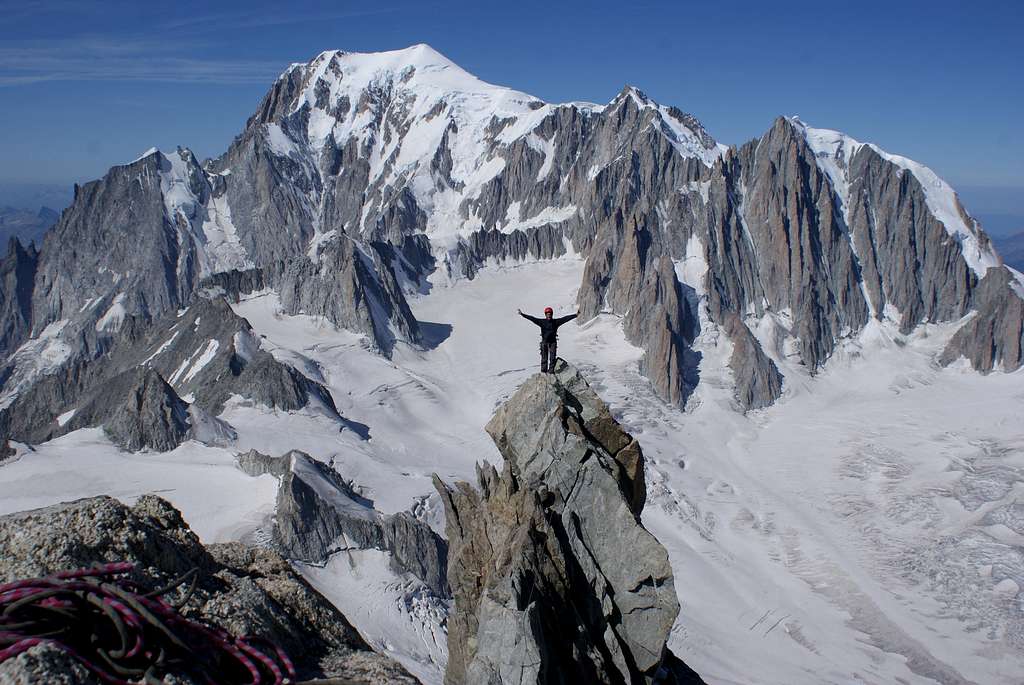
A bit of climbing history
The first attempt to Dent du Gèant, still waiting to be climbed for the first time, was undertaken by Albert Frederick Mummery with Alexander Burgener, who had already won some vertical spires on Mont Blanc group, such as Grepon and Aiguille des Grands Charmoz. They planned to summit this stunning spire on summer 1880. Mummery and Burgener started the ascent, but they gave up the attempt in front of a granite slab, too smooth to be won in free climbing: the current impressive Burgener slab. According to his crystalline ethics, Mummery refused to use any artificial means. On that circumstance he left in place a bottle containing a message which said: “impossible by fair means”.
Two years later, the first ascent of Punta Sella was completed on July 28th by the three Aostan alpine guides Jean-Joseph Maquignaz, the son Battista and the nephew Daniele with wide use of artificial means. The party was led by Daniel on the hardest moves. The climb took place along the South-West face, after three days of preparation. The next day, July 29th, the guides repeated the climb with their customers Sella: the brothers Alessandro, Alfonso, Corradino and cousin Gaudenzio. But the six climbers, divided into two parties, gave up the highest point due to time constraints, so the Northern summit remained to be conquered.
The first ascent of the Northern summit, the highest, was completed the same year, on August 20th 1882, by William Woodman Graham with the French guides Alphonse Payot and Auguste Cupelin. The highest peak was named Punta Graham.
Getting there
Approach from Courmayeur
A good start point is the Torino Hut, which is right next to the second station of the cable car starting from La Palud, Courmayeur, on italian side of Monte Bianco, close to the entrance of the homonym tunnel. The approach from Chamonix, in the french side of Monte Bianco, is longer.
- From Turin and Milan: follow the A5-E25 Motorway and exit Courmayeur, reaching the hamlet of La Palud m. 1370.
- From France: through the Tunnel of Monte Bianco
- From Switzerland: through the Great St.Bernard Tunnel or the Great St.Bernard Col or via Chamonix and Tunnel of Monte Bianco.
Getting to Rifugio Torino
From Entrèves - La Palud take the cable-car leading directly to Rifugio Torino (exit second station, the first one is the middle Pavillion station, the third one is Punta Helbronner). Funivie del Monte Bianco
Route Description
Dent du Géant SW Face Normal route report - UIAA scale
Summit altitude: 4013 m
Difficulty: AD, V max without use the fixed ropes (UIAA scale)
Climbing length: 350 m
Equipment: pegs, bolts, fixed ropes
Exposure: SW
First ascent: Jean-Joseph, Battista and Daniele Maquignaz, July 28th 1882
Starting point: Rifugio Torino
A beautiful classic route up a superb spire. The setting is great, with breathtaking views all around over Mont Blanc massif
Approach - From Rifugio Torino reach Colle del Gigante 3365 m and follow the glacier downhill, skirting the rocky spur of Aiguilles Marbrées, and then up towards North-East in the direction of the glacial valley overlooked by the rocky band that supports the "gengiva" of Dent du Géant. There is usually a track across the glacier.
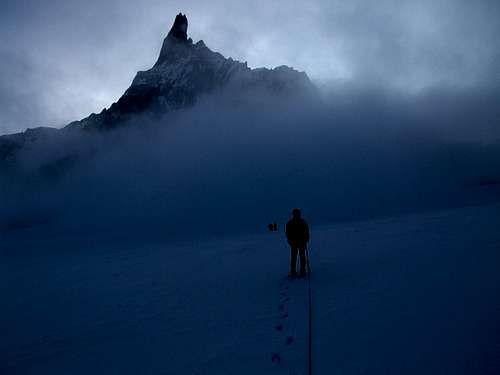
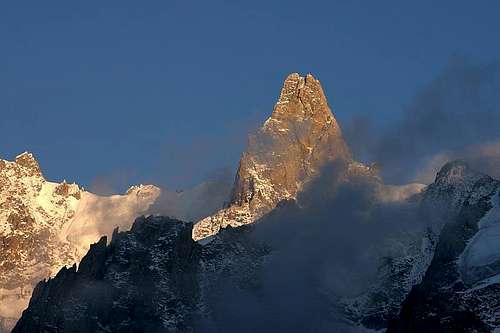
At the left edge of the rocky pedestal locate a reddish pinnacle near a shoulder and reach this latter along a snowy gully or climbing the rocks on the right. From the shoulder climb the loose rocky rib definitely rightward (East, cairns) without compulsive route in the direction of the summit main ridge. Also in summer, after a snowfall, it's possible to find this rocky rib covered with snow. Once on the main ridge, follow it and reach the base of a huge pinnacle.
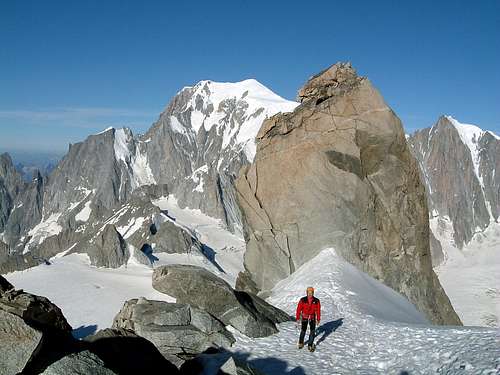
Bypass rightward the pinnacle, on snowy and rocky ground, then up a snowy slope reaching the so-called Salle à Manger (3850 - 2.30 hours from the hut), a snowy terrace cluttered with blocks. Crossing to the left on snow head towards the SW ridge of Dent du Géant, where it starts the Normal route. Equipped belay on a platform. Route report The "Normal route to Giant's Tooth" is a climb that over time has undergone several changes in the protection system on site. So, given the presence of multiple stopping points, the pitches and the belays under described are clearly suggested as one of different possible solutions. Guides have put up some fixed ropes along the route, it would be a much tougher climb without those. The ropes are hemp-made and rather thick, similar to those ones on the Hornligrat to Matterhorn.
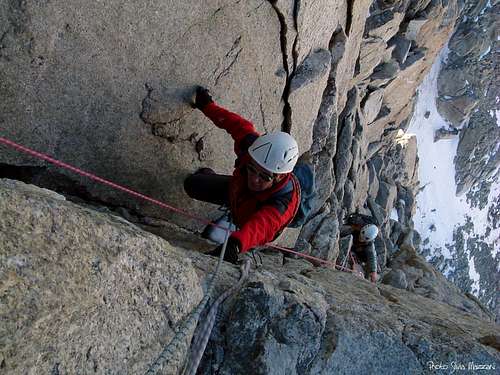
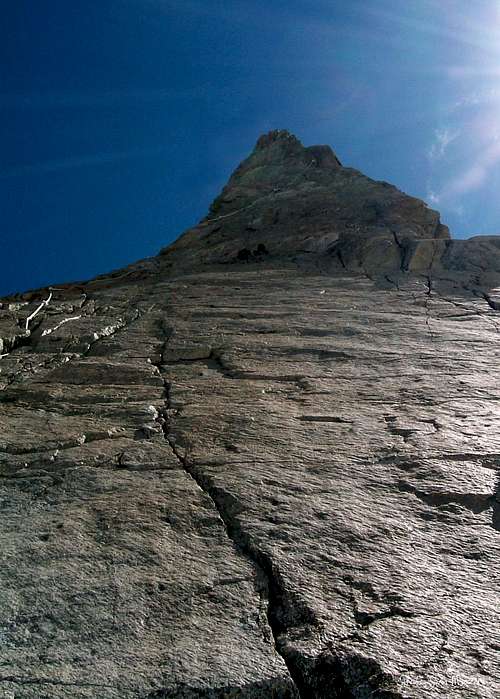
L1 - Skirt the edge to the left and enter an open dihedral. First belay inside, III, IV, 35 m
L2 - Climb the dihedral until its end and exit left onto a terrace on the SW wall below the wide and characteristic "Burgener slab" (possible belay on the terrace). Here it starts the system of fixed ropes. Slanting left reach the left edge of the beautiful slab and climb a crack getting the belay, III, IV (fixed rope after the terrace), 55 m
L3 - This pitch has an impressive exposition and despite the fixed ropes the difficulty should not be underestimated. Climb the cracks on the left edge of the steep slab, then a short wall. Slanting right in the direction of a beautiful flake. Climb up and belay in the middle of the flake, IV, IV +, III, fixed rope, 45 m.
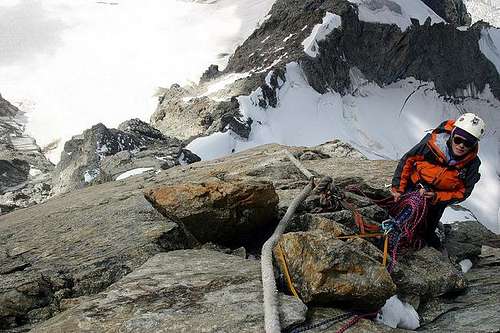
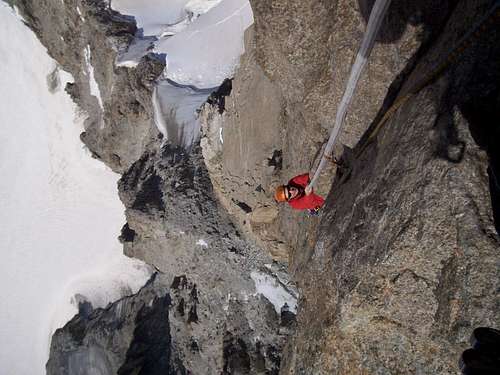
L4 - The fourth pitch (V) is athletic and tiring. It starts on the left of Burgener slabs, to finish, after following a slanting right crack, on the famous vertical wall-dihedral. Through the last meters of the flake you will reach the base of the dihedral, with a difficult starting step. After about 6 meters, the dihedral is interrupted by a small terrace. Move to the balcony slightly to the right to resume the dihedral, now less vertical, until the belay, IV, V, IV, fixed rope, 40 m
L5 - The fifth length (IV+) climbs vertically again, to end on the long airy crest that leads a few meters below Punta Sella, IV+, III, 50 m., fixed first piece rope.
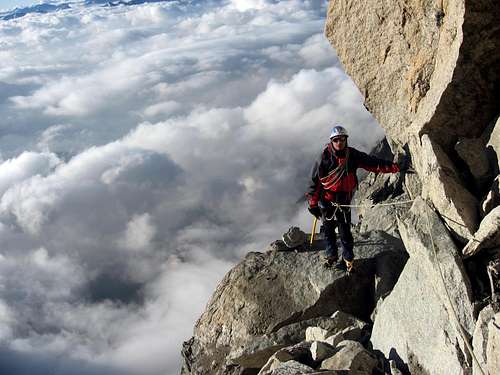

L6 - The sixth pitch (IV) climbs a short smooth slab, leading to the summit of the Punta Sella 4009 m, the South-West summit. Then it follows an airy crest in slight descent, then a vertical wall 3 or 4 m long, with a fixed rope, to reach the notch between the two summit, then Punta Graham 4014 m, the higher, where there is a bronze Madonna and an equipped belay, III, IV, 30 m
The summit is really great! It's tiny and the views across the Mt. Blanc Massif are incredible!
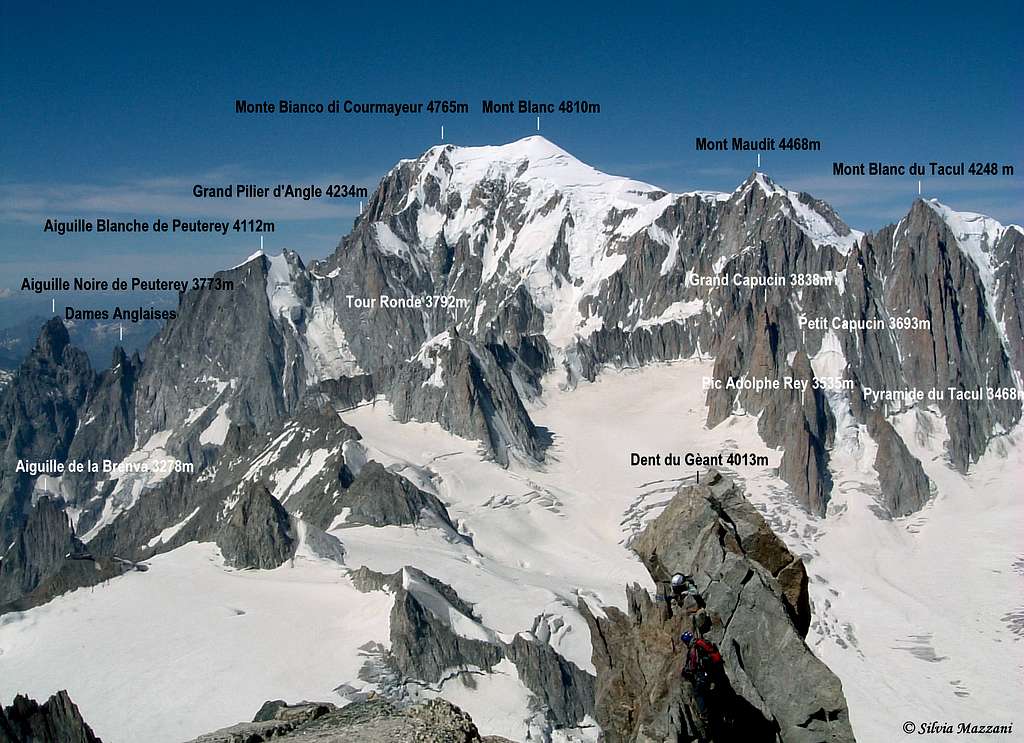
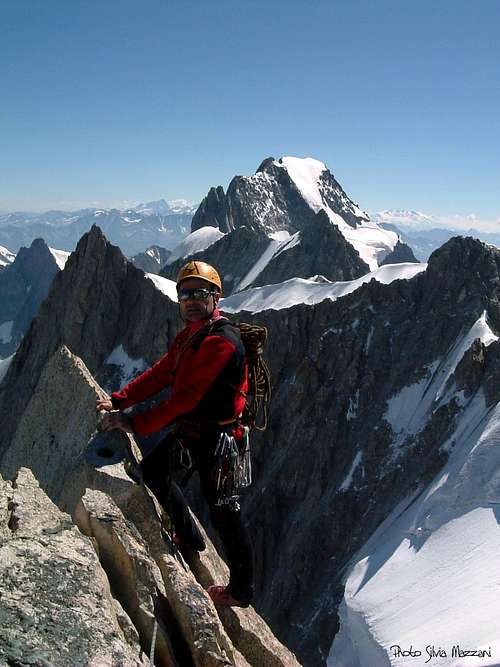
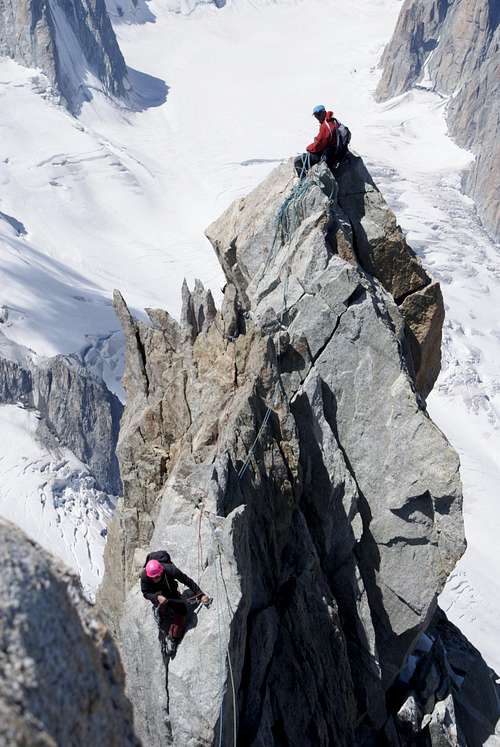
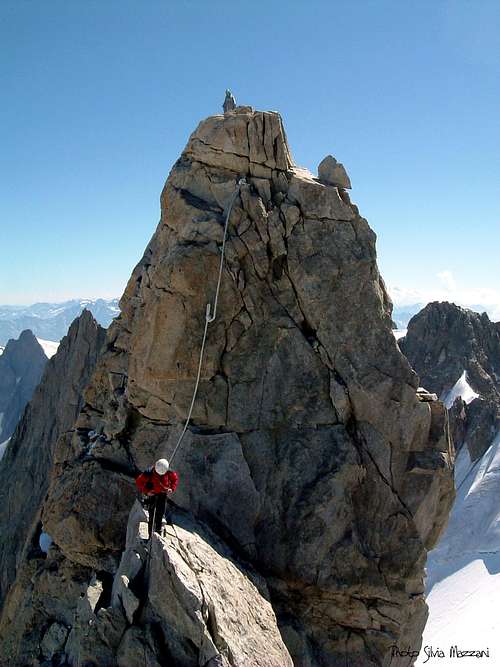
Descent - two options:
A) Abseiling down the same route, a solution not advisable when other parties are still climbing up
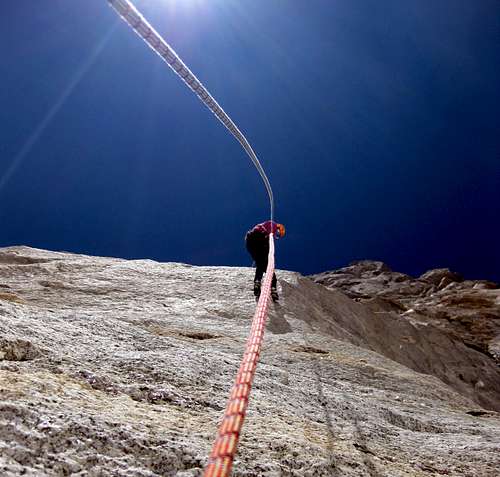
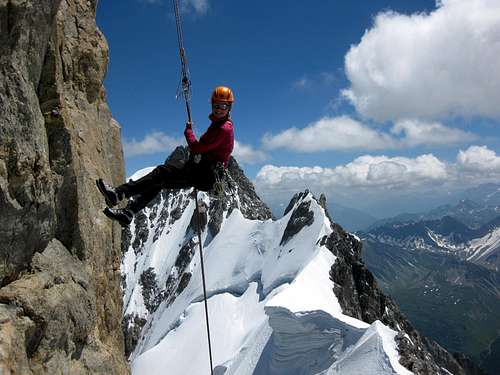
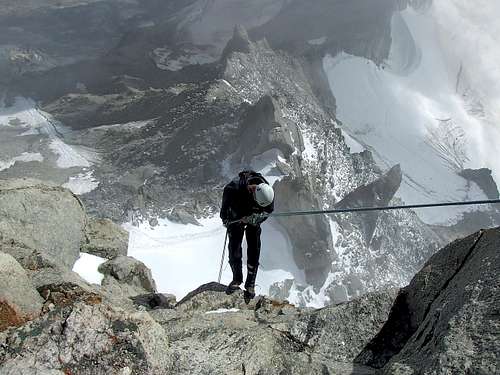
B) Abseiling down the south wall, the most direct and fast, but very exposed. Return at the base of the collar before the summit with Madonna where it's located the first abseil anchor. With three abseils (ropes 60 m) you arrive on the snowfield to the right of Burgasser (South wall), the last one is 10 meters.
Essential Gear
Crampons, ice axe, mountain boots for the glacier. Helmet, harness, lanyards, slings and quickdraws, rope
Red tape
No fees, no permits required
Hut
- Rifugio Torino m. 3375 – C.A.I. Sez. di Torino
When to climb
A cold place! The wall, facing SW, catchs the sun late in the morning. Best season goes from July to September.
Meteo
Guidebooks
- Guidebooks
- "Il grande libro dei 4000" by Marco Romelli, Valentino Cividini - Idea Montagna Editore, 2015
- “Tutti i 4000” – L’aria sottile dell’alta quota” – CLUB 4000 CAI TORINO – Vivalda Editori
- “The 4000 of the Alps” by Richard Goedeke (CAAI) – All the normal routes to the 4000m. summits of the Alps
- “I Quattromila delle Alpi” by Karl Blodig and Helmut Dumler – Zanichelli Ed.
- "Monte Bianco" vol. 2 - Guida Vallot
- "Monte Bianco" vol.1 - Gino Buscaini, Guida dei Monti di Italia CAI-TCI, 1994
Maps
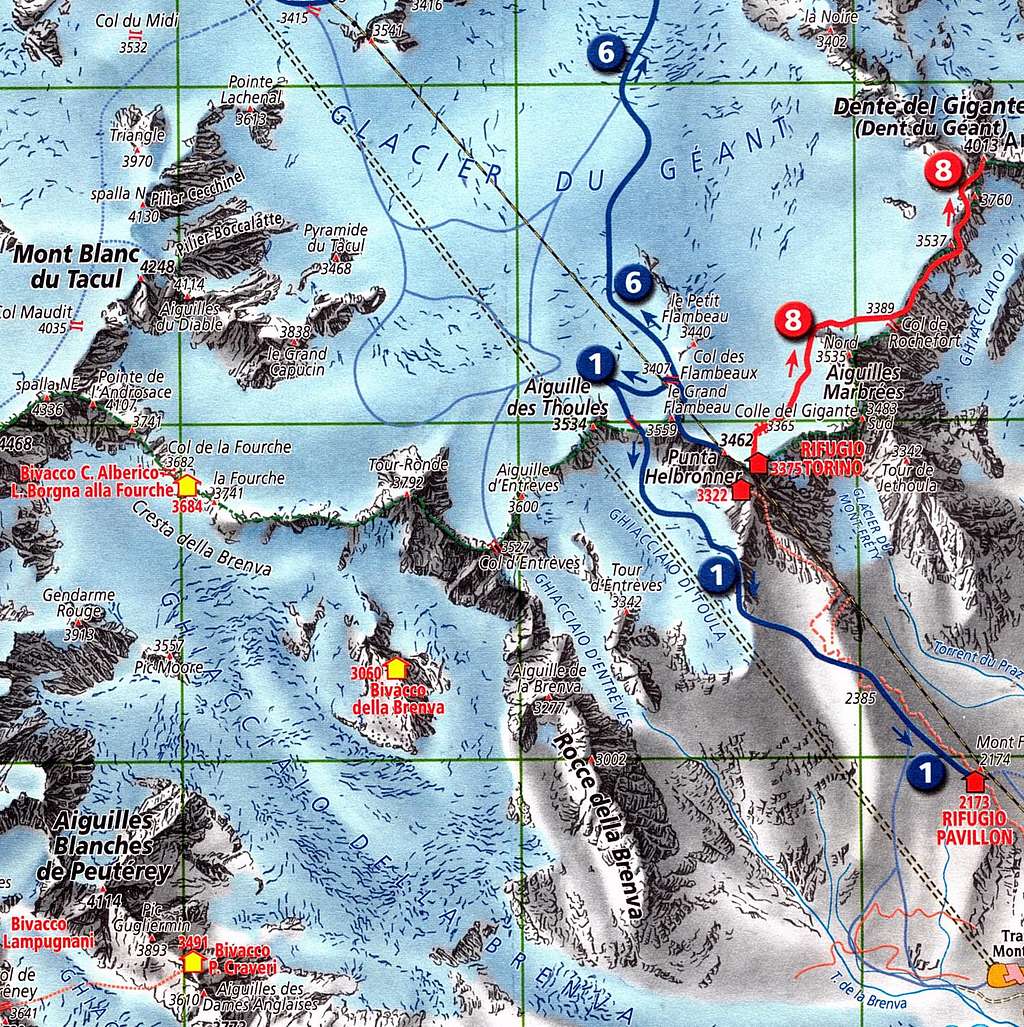
- Meridiani Montagne “ Monte Bianco” map 1:30.000
- Swiss Topo 292 Courmayeur
- IGN 3531ET St.Gervais Les Bains – Massif du Mont Blanc






